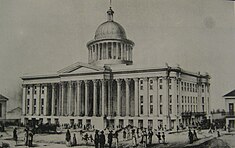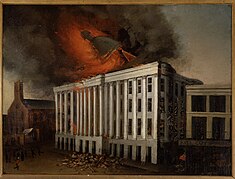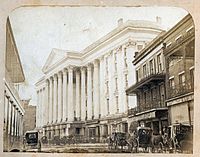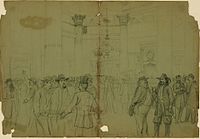St. Charles Hotel, New Orleans
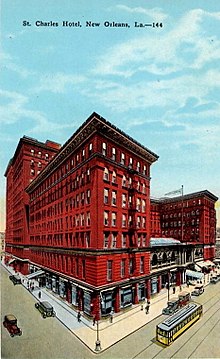
The St. Charles Hotel was a hotel on St. Charles Avenue in New Orleans, Louisiana.[1] One of the first of the great hotels of the United States, the original Grecian palace-style building, opened in 1837, has been described by author Richard Campanella as "one of the most splendid structures in the nation and a landmark of the New Orleans skyline".[2] It was some time before it found a rival in the Astor House, of New York City. It was said that the hotel's Parlor P had probably witnessed more important political events than any room or any building in the country, outside of the Capitol at Washington, D.C.[3] During the Civil War, Union General Benjamin Butler seized the hotel to use for his headquarters after the city surrendered. The third incarnation of the hotel was finally demolished in 1974.
First building
[edit]The old St. Charles or Exchange Hotel, as it was generally called, was commenced in the summer of 1835. It cost US$600,000 to build, in addition to the $100,000 paid for the ground, and was one of the first large buildings erected above Canal street. It had a neoclassical front, capped by a tall, white cupola, second in size to only the dome of the Capitol at Washington.[3] Center with the cupola was a projecting portico of six Corinthian columns, from which a flight of marble steps led to the hotel. The bar-room in the basement was octagonal in shape, 70 feet (21 m) in diameter and 20 feet (6.1 m) high, having an exterior circle of Ionic columns. The architecture of this room was Ionic, and that of the saloon immediately over the ball room which was 18 feet (5.5 m) high, Corinthian. From the street, a flight of marble steps led to the lower saloon, at the summit of which was a handsome marble statue of Washington. From the saloon a grand spiral staircase continues up to the dome, with a gallery stretching around it on each of the upper stories. The dome was 46 feet (14 m) in diameter, surmounting an octagon building elevated upon an order of fluted columns. Above the dome was an elegant Corinthian turret. A circular room under the dome on the floor of which the spiral staircase terminated possessed a beautiful gallery, 11 feet (3.4 m) wide, from which the whole city could be seen, at a height of 185 feet (56 m).[3]
The hotel opened in 1837 and was destroyed by fire on January 18, 1851.[4]
One history of New Orleans described slave sales at the St. Charles: "These sales were held in the famous barroom of the hotel, a semi-circular room on the ground floor, with huge brick columns supporting the vast structure above. There were two auction blocks, one at each end of the bar, this one for male slaves, that one for females. Sometimes there were only a few negroes to be disposed of; sometimes there were a great many."[5]
Second building
[edit]A larger hotel was rebuilt at a cost of $800,000. Barker retained very little interest in the hotel, and took no part in the rebuilding.[6] The second hotel opened in January 1853, during a time of political strife between 1851 and 1861, but became a highly successful venture. Col. R. E. Rivers, who was proprietor of the house, directed it, either alone or with a partner, from 1869. The office force consisted of Messrs. Kelsev, Mitchell, Davis and Wallace.[4] In 1878, the St. Charles Hotel Company, who owned it, made $100,000 worth of improvements to the building, which thoroughly modernized it and gave it additional rooms. In 1888, the house had 400 rooms, accommodation for between 600 and 700 guests. There were 30 parlors and 100 bathrooms. It peaked in popularity during the Mardi Gras, when the building often become overcrowded.[4] The gold service of the hotel, estimated to be worth $16,000, was only used on extraordinary occasions.[4] The second hotel burned down too, on April 28, 1894.[7]
Third building
[edit]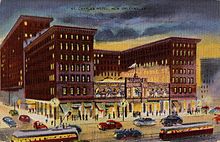
The third St. Charles Hotel opened on February 1, 1896. One author mentions that this building had "strings of colored lights" along its "mezzanine balcony", and contained trees in the hotel lobby.
The 1956 Sugar Bowl after-game dinner banquet was hosted here with civil rights icon Bobby Grier.[8] Sheraton Hotels bought the St. Charles in 1959 for $5 million[9] and renamed it the Sheraton-Charles Hotel. The hotel was sold to local developer Louis J. Roussel Jr. in 1965,[10] though Sheraton continued to operate it. On August 5, 1973,[11] Rousell announced he would redevelop the site of the Sheraton-Charles. It closed and was demolished in 1974. The planned replacements, a 56-story office tower and a 40-story, 800-room hotel to be named the Grand St. Charles Hotel,[12] were never built. Instead the lot sat vacant for nearly a decade, until the Place St. Charles tower was erected in 1984.[13]
See also
[edit]References
[edit]- ^ Palmquist & Kailbourn 2005, p. 400.
- ^ Campanella, p. 212.
- ^ a b c Coleman 1885, p. 72.
- ^ a b c d Morrison 1888, p. 78.
- ^ Kendall 1939, p. 147.
- ^ Barker 1855, p. 223.
- ^ http://richcampanella.com/assets/pdf/article_Campanella_Preservation-in-Print_2015_April_St%20Louis%20and%20St%20Charles%20Hotels.pdf [bare URL PDF]
- ^ "Grier Family Announces Project And Celebrated Juneteenth In Atlanta". menafn.com.
- ^ Campanella, Richard (2017). Cityscapes of New Orleans. Baton Rouge: Louisiana State University Press. p. 140. ISBN 9780807168349. OCLC 975998376.
- ^ Pontchartrain, Blake. "Blake Pontchartrain: Remembering Reno's restaurant". The Advocate. Retrieved 2018-08-26.
- ^ "The Delta Democrat-Times from Greenville, Mississippi on August 6, 1973 · Page 14". Newspapers.com. Retrieved 2018-08-26.
- ^ "The Town Talk from Alexandria, Louisiana on April 11, 1974 · Page 21". Newspapers.com. Retrieved 2018-08-26.
- ^ http://richcampanella.com/assets/pdf/article_Campanella_Preservation-in-Print_2015_April_St%20Louis%20and%20St%20Charles%20Hotels.pdf [bare URL PDF]
Bibliography
[edit] This article incorporates text from this source, which is in the public domain: Barker, Jacob (1855). Incidents in the Life of Jacob Barker, of New Orleans, Louisiana: With Historical Facts, His Financial Transactions with the Government and His Course on Important Political Questions, from 1800 to 1855 (Public domain ed.). p. 223.
This article incorporates text from this source, which is in the public domain: Barker, Jacob (1855). Incidents in the Life of Jacob Barker, of New Orleans, Louisiana: With Historical Facts, His Financial Transactions with the Government and His Course on Important Political Questions, from 1800 to 1855 (Public domain ed.). p. 223. This article incorporates text from this source, which is in the public domain: Coleman, W. H. (1885). Historical Sketch Book and Guide to New Orleans and Environs: With Map. Illustrated with Many Original Engravings; and Containing Exhaustive Accounts of the Traditions, Historical Legends, and Remarkable Localities of the Creole City (Public domain ed.). W. H. Coleman. p. 72.
This article incorporates text from this source, which is in the public domain: Coleman, W. H. (1885). Historical Sketch Book and Guide to New Orleans and Environs: With Map. Illustrated with Many Original Engravings; and Containing Exhaustive Accounts of the Traditions, Historical Legends, and Remarkable Localities of the Creole City (Public domain ed.). W. H. Coleman. p. 72. This article incorporates text from this source, which is in the public domain: Morrison, Andrew (1888). New Orleans and the New South (Public domain ed.). Graham.
This article incorporates text from this source, which is in the public domain: Morrison, Andrew (1888). New Orleans and the New South (Public domain ed.). Graham.- Campanella, Richard. New Orleans Then and Now. Pelican Publishing. ISBN 978-1-4556-0959-8.
- Kendall, John S. (January 1939). "Shadow Over the City". The Louisiana Historical Quarterly. 22 (1). New Orleans: Louisiana Historical Society: 142–165. ISSN 0095-5949. OCLC 1782268. LDS Film 1425689, Image Group Number (DGS) 1640025 – via FamilySearch Digital Library.
- Palmquist, Peter E.; Kailbourn, Thomas R. (2005). Pioneer Photographers from the Mississippi to the Continental Divide: A Biographical Dictionary, 1839-1865. Stanford University Press. ISBN 978-0-8047-4057-9.
- Scott, Peggy. Christmas in New Orleans. Pelican Publishing. ISBN 978-1-4556-0217-9.
External links
[edit]- Hotels in New Orleans
- Defunct hotels in Louisiana
- 1837 establishments in Louisiana
- Hotels established in 1837
- Hotel buildings completed in 1837
- Hotel buildings completed in 1853
- Hotel buildings completed in 1896
- Buildings and structures demolished in 1974
- Demolished buildings and structures in Louisiana
- Demolished hotels in the United States

